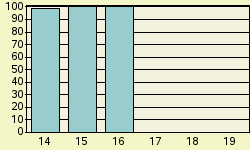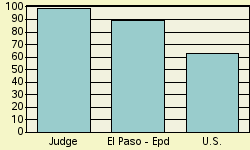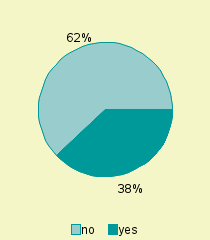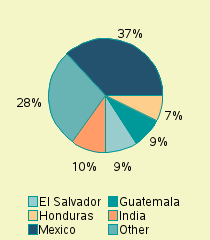Judge Sunita B. Mahtabfar
FY 2014 - 2019, El Paso - Epd Immigration Court
Attorney General Eric Holder appointed Judge Mahtabfar in February 2013. Judge Mahtabfar received a bachelor of arts degree in 1994 from the University of Texas at Austin in Austin, Texas, and a juris doctorate in 1998 from Thurgood Marshall School of Law in Houston. From November 2006 to February 2013, she served as an attorney in the Office of the Assistant Chief Counsel, U.S. Customs and Border Protection, Department of Homeland Security (DHS), in El Paso, Texas. From February 2003 to November 2006, she served as an asylum officer for U.S. Citizenship and Immigration Services, DHS, in Houston. From June 2000 to February 2003, Judge Mahtabfar served as a staff attorney for the Department of Public Safety in Houston. Judge Mahtabfar is a member of the State Bar of Texas.
Deciding Asylum Cases
Detailed data on Judge Mahtabfar decisions were examined for the period covering fiscal years 2014 through 2019. During this period, Judge Mahtabfar is recorded as deciding 152 asylum claims on their merits. Of these, she granted 2, gave no conditional grants, and denied 150. Converted to percentage terms, Mahtabfar denied 98.7 percent and granted (including conditional grants) 1.3 percent. Figure 1 provides a comparison of Judge Mahtabfar's denial rate fiscal year-by-year over this recent period. (Rates for years with less than 25 decisions are not shown.)
Nationwide Comparisons
Compared to Judge Mahtabfar's denial rate of 98.7 percent, nationally during this same period, immigration court judges denied 63.1 percent of asylum claims. In the El Paso - Epd Immigration Court where Judge Mahtabfar was based, judges there denied asylum 89.6 percent of the time. See Figure 2.
Judge Mahtabfar can also be ranked compared to each of the 456 individual immigration judges serving during this period who rendered at least one hundred decisions in a city's immigration court. If judges were ranked from 1 to 456 - where 1 represented the highest denial percent and 456 represented the lowest - Judge Mahtabfar here receives a rank of 8. That is 7 judges denied asylum at higher rates, and 448 denied asylum at the same rate or less often. Ranks are tallied separately for each immigration court. Should a judge serve on more than one court during this period, separate ranks would be assigned in any court that the judge rendered at least 100 asylum decisions in.
Why Do Denial Rates Vary Among Judges?
Denial rates reflect in part the differing composition of cases assigned to different immigration judges. For example, being represented in court and the nationality of the asylum seeker appear to often impact decision outcome. Decisions also appear to reflect in part the personal perspective that the judge brings to the bench.
Representation
If an asylum seeker is not represented by an attorney, almost all (89%) of them are denied asylum. In contrast, a significantly higher proportion of represented asylum seekers are successful. In the case of Judge Mahtabfar, 61.8% were not represented by an attorney. See Figure 3. For the nation as a whole, about 19% of asylum seekers are not represented.
Nationality
Asylum seekers are a diverse group. Over one hundred different nationalities had at least one hundred individuals claiming asylum decided during this period. As might be expected, immigration courts located in different parts of the country tend to have proportionately larger shares from some countries than from others. And, given the required legal grounds for a successful asylum claim, asylum seekers from some nations tend to be more successful than others.
For Judge Mahtabfar, the largest group of asylum seekers appearing before her came from Mexico. Individuals from this nation made up 36.8 % of her caseload. Other nationalities in descending order of frequency appearing before Judge Mahtabfar were: India (9.9 %), El Salvador (9.2%), Guatemala (8.6%), Honduras (7.2%). See Figure 4.
In the nation as a whole during this same period, major nationalities of asylum seekers, in descending order of frequency, were El Salvador (17.3%), China (13.5%), Honduras (13.3%), Guatemala (13.0%), Mexico (12.1%), India (3.8%), Haiti (2.1%), Nepal (1.6%), Cuba (1.2%), Eritrea (1.1%), Cameroon (1.1%), Bangladesh (1.0%), Ecuador (0.9%).




